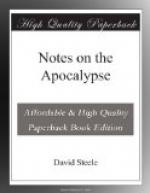The meaning of the “seven stars and seven candlesticks” is then explained to John. The word, “are,” is used in a figurative sense, and not to be taken literally. It means here, symbolize, represent or signify. It is to be interpreted in the same sense as in the following places of sacred Scripture:—“It is the Lord’s passover.” (Exod. xii. 11.) “That rock was Christ.” (1 Cor. x. 4.) “This is my body.” (Matt. xxvi. 26.) None but a Papist will have any difficulty here, or perhaps,—a Lutheran!
CHAPTER II.
Some commentators, among whom may be mentioned the learned Dr. Gill, a leading Antipedobaptist minister of England, have imagined, that the seven epistles addressed to the Asiatic churches, contain a mystical prophecy of the church general, covering the whole period of her history from the apostolic age till the end of the world. According to this fancy,—for it is nothing more than a fancy; the church in Smyrna, will represent the church’s condition in the second stage of her history, when Arianism prevailed! And the Laodicean must represent her last, and so her worst condition! How will this harmonize with the 20th chapter, where she appears in triumph over all her antichristian foes? This is given as a specimen of the unbridled fancy and licentious imagination with which even good men may be tempted to approach the reading and interpreting of this important and instructive part of God’s word. But Peter informs us that some persons in his time, “wrested” those parts of Paul’s writings which were “dark and hard to be understood:” and this was not the worst of their conduct, for they treated “the other scriptures also” in the same reckless and irreverent manner, which were neither dark nor hard to be understood. (2 Pet. iii. 16.) These epistles are no more mystical or prophetical than those of the apostle Paul. They are simply and properly descriptive, although like all other epistles, they are applicable to the church general in all ages, and equally suited to the case of individuals, as is clear in the close of each:—“If any man have an ear, let him hear.”




